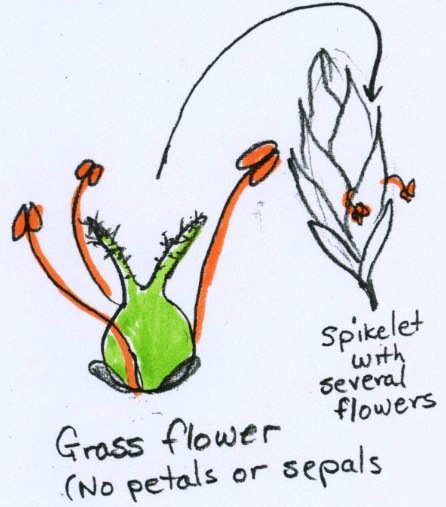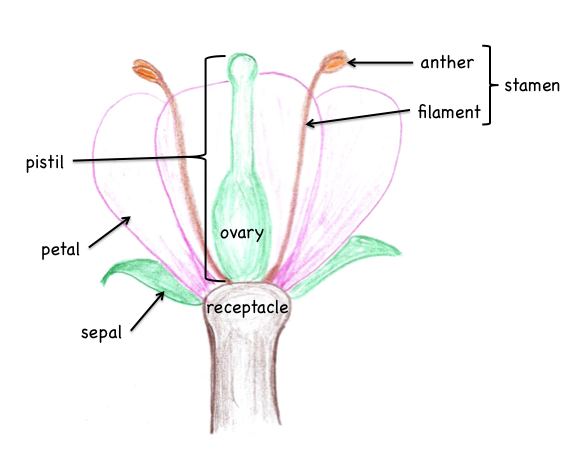
Flower structure
A flower is a modified shoot that contains the reproductive parts of a flowering plant (an angiosperm).
A flower may have four types of parts (modified leaves) attached to the end of the stem. (This stem tip is called the receptacle.)
Pistils consist of one or more fused carpels. The basal part of the pistil is the ovary. It surrounds ovules. Generally after fertilization, the ovules become seeds and the ovary becomes a fruit, enclosing the seeds. Pistils are the most distal parts of the flower.
Stamens, the next set of flower parts, consist of anthers, containing pollen, and filaments (the stalks of the stamens).
Petals, the next set of flower parts, are sterile and often function to attract pollinators.
Sepals, the most proximal set of flower parts, serve to surround and protect the flower bud. They are often photosynthetic.
Together, the petals and sepals (all of the sterile parts of the flower), are called the perianth.
The "gynoecium" refers to all of the carpels in a flower. A carpel is a modified leaf of a flowering plant that has ovules on its edges. Carpels fuse singly or in groups to enclose their ovules.
A flower may have one to many carpels.
If a flower has multiple carpels, they may be separate, each carpel forming a separate pistil, or fused together, forming a single compound pistil.
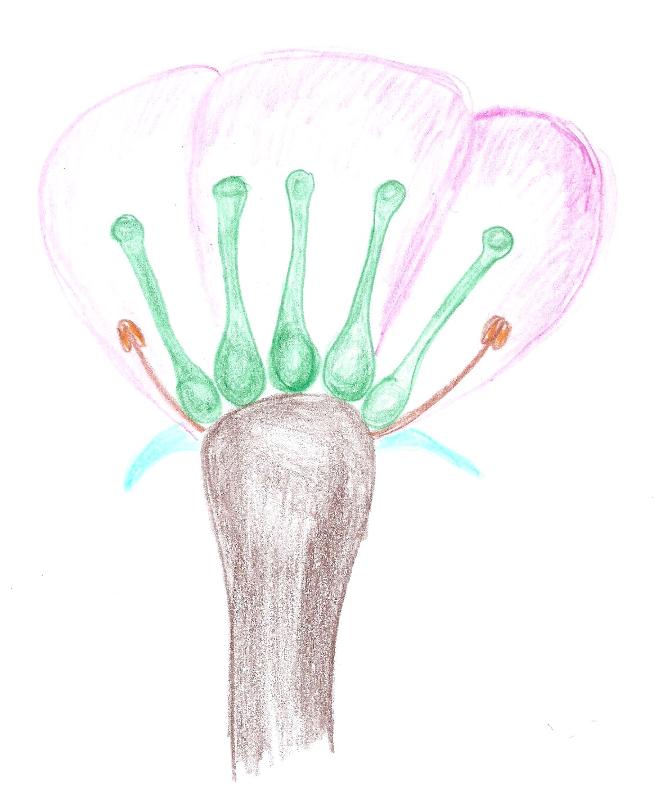
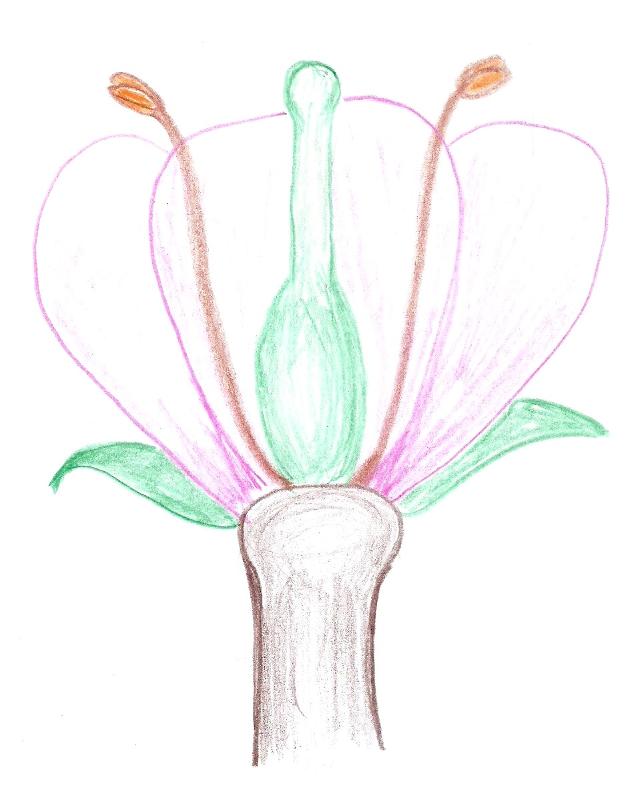
To determine the number of carpels in a pistil, you must recognize that carpels evolved from leaf-like structures with ovules on their edges.
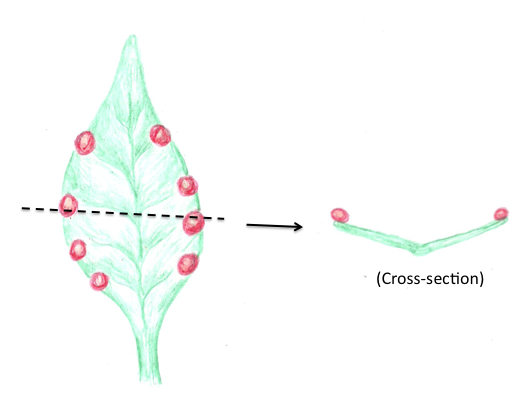
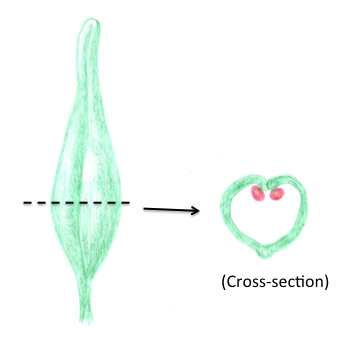
A cross-section of the ovary of a pistil will often reveal how many carpels make up a pistil. Look at where ovules are attached in the ovary and envision how leaf-like structures with ovules on their edges must be fused to form that ovary.
Cross-sections of ovaries from three different pistils are shown below:
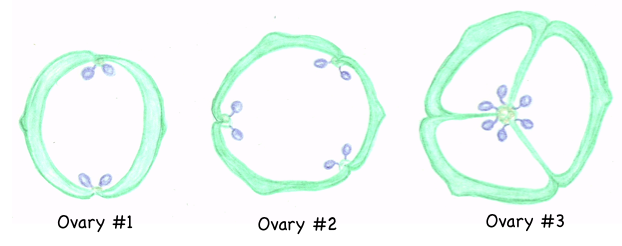
How many locules are in Ovary #1? (Click here)
How many locules are in Ovary 2? (Click here)
How many locules are in Ovary #3? (Click here)
How many CARPELS made up the pistil that had ovary #1? (Click here)
How many CARPELS made up the pistil that had ovary #2? (Click here)
How many CARPELS made up the pistil that had ovary #3? (Click here)
Each pistil has a stigma, where pollen lands, a style, though which pollen tubes have to grow to reach eggs in the ovules, and an ovary.
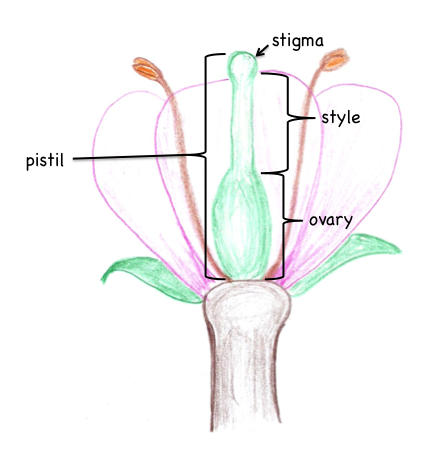
An ovary may have one or more locules (internal spaces or voids in which the ovules reside).
If an ovary contains more than one locule, the walls between locules are called septa.
Ovules are attached to a part of the ovary wall called the placenta. This placenta often looks lighter and less dense that the rest of the ovary wall.
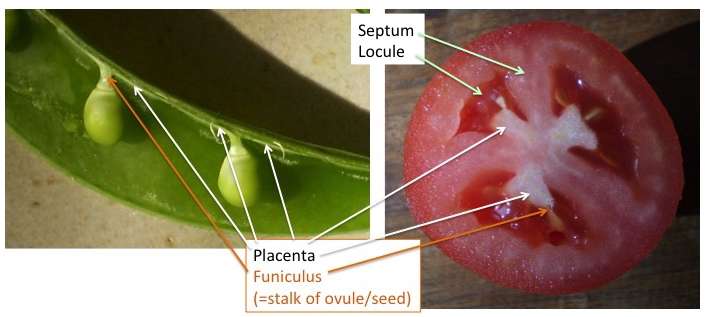
Several patterns of placentation are recognized.
Marginal placentation consists of a vertical line of placenta up one side of a locule in an ovary with a single locule.
Parietal placentation is similar, but consists of two-to-many vertical lines of placenta up the inner walls of an ovary with a single locule. Parietal placentation is found in some ovaries of compound pistils (pistils consisting of more than one fused carpel).
Axile placentation exists in ovaries of compound pistils that have multiple locules. In axile placentation, the placenta exists in the center of the ovary, where all of the septa join.
Free-central placentation consists of a single, central column of placenta in an ovary with one locule. It is thought to have evolved from an ancestor with axile placentation through the evolutionary loss of septa within the ovary.
Basal placentation consists of a lump or very short column of placenta in the bottom of an ovary.
Basal placentation is a very derived pattern of placentation. Whereas marginal placentation, parietal placentation, and axile placentation give good clues as to how many carpels are in a pistil, most of those clues have disappeared in pistils with basal placentation.
 The figure here shows the gynoecium in the flower of four different species. Each gynoecium contains three carpels.
The figure here shows the gynoecium in the flower of four different species. Each gynoecium contains three carpels.
Test your knowledge below.
An ovary may be "superior" or "inferior".
When the ovary is distal to the attachment of all the other flower parts, it is considered "superior". The flower below has a superior ovary.

When other flower parts are attached to the "top" of the ovary, or distal end of the ovary, the ovary is considered inferior.
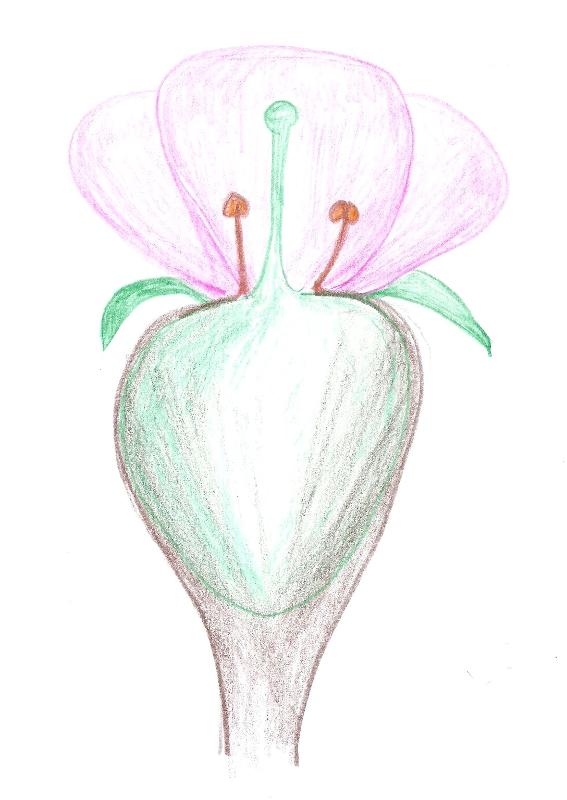
Inferior ovaries result when the bases of the other flower parts (stamens, petals and sepals) are fused to the outside of the ovary, or when the ovary is sunk into the receptacle.
Check your understanding:

The "androecium" refers to all of the stamens in a flower.
A stamen consists of an anther and a filament. The anther has one, two, or four pollen sacs, each containing pollen. The stalk of the anther is the filament. Sterile (nonreproductive) tissue between pollen sacs (an extension of the filament) is called the connective.
Anthers may be connected to the filament at their base (called "basifixed" anthers in most texts) or at their backs (called "dorsifixed" anthers in many texts). In some cases, anthers attached to a filament at their backs can swing freely on their filaments, and are called versatile anthers.
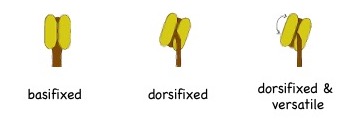
Anther sacs may dehisce by pores, by longitudinal slits, by transverse slits, or by valves to release pollen grains.

Stamens may have appendages in various locations, and their connective may take on different shapes. Examples are shown below.
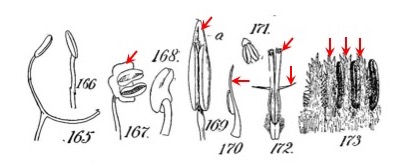
Some flowers have one or more staminodes (sterile stamens or stamens without functional anthers).
The corolla (a term for all of the the petals of a flower) and the calyx (a term for all of the sepals of a flower) make up the perianth. In most cases, the petals and sepals look very different from each other. In other cases, they look very similar and may be referred to as "tepals", rather than petals or sepals. "Perianth parts" is a general term for petals and/or sepals that is used in many plant identification keys.
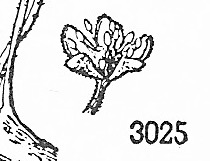 Some flowers have only one whorl of perianth parts. That is, the perianth parts (usually the sepals) form a single ring of parts on the receptacle. Examples are the flowers of Croton: these have sepals and no petals.
Some flowers have only one whorl of perianth parts. That is, the perianth parts (usually the sepals) form a single ring of parts on the receptacle. Examples are the flowers of Croton: these have sepals and no petals.
Some flowers have two whorls of perianth parts that are differentiated into petals and sepals.
Other flowers have two whorls of perianth parts that look very similar. Many lily-like flowers are like this. The flower of Hesperoyucca whipplei (below) has what the Jepson Manual describes as "perianth parts 6, in 2 petal-like whorls". You can see that three of the petal-like perianth parts are in a ring or whorl that is above or distal to the attachment of the other three.

In some cases, the sepals are fused together to form a "calyx tube". Petals may also be fused together to form a "corolla tube".

The symmetry of a flower is generally determined by the shape of its corolla.
If there is only one way you can cut a flower to get mirror-images of the flower, the flower is bilaterally symmetrical.
If there are multiple ways you can cut a flower to get mirror images, the flower is radially symmetrical.
If there are two, and only two ways you can cut the flower to get mirror images, the flower is biradially symmetrical.

Corollas of fused petals have various shapes.
There are several radially symmetrical shapes:
Urceolate corollas are urn shaped, widening rapidly at the base and narrowing toward the tip.
Campanulate corollas are bell-shaped, being rounded at the base then having straight or gradually widening sides toward the tip.
Funnelform or funnel-shaped corollas gradually increase in diameter from the base toward the tip.
Salverform corollas have a fairly abrupt transition between a narrow tube and a distal, flat limb where the corolla lobes spread into a lobed disk or wheel-like structure. The throat of a salverform corolla is the region where the limb meets the tube.
Rotate corollas are like salverform corollas with either no tube or a very short tube. They form a fairly flat wheel-like structure.
Bilateral flowers with 5 fused petals often form a corolla with two lips (bilabiate corollas). Usually the lower lip has three lobes and provides a landing platform for pollinators; the upper lip has two lobes.

Test your knowledge:
Nectaries (glands that produce nectar) can be found on many plant parts. Many are found around the base of a pistil. Some are found on petals. These may be on relatively flat petals, or in spurs on petals.
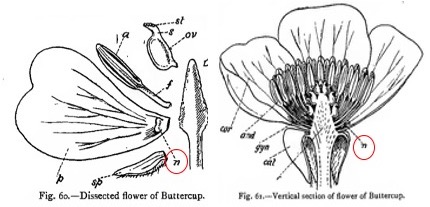
A spur is a narrow, cone-like projection of a petal. There is generally a nectary at the end.
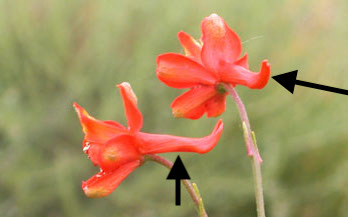
A sac is a more rounded pouch in a petal:

Some petals are clawed. Where an organ like a petal is narrow near the point of attachment and much broader distally (usually abruptly flaring out), the narrow proximal region is called the "claw" and the broader distal region is called the "limb". (Note that "limb" is also used to describe the distal, flared region of a corolla such as a salverform corolla.)
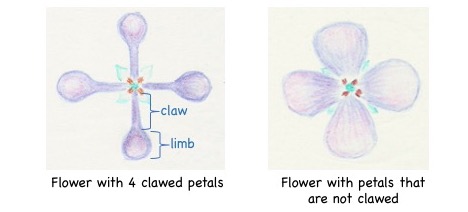
Some flowers have a hypanthium, cylindrical or cup-like structure that has the petals, sepals, and stamens attached to its rim. A flower with a hypanthium may have a superior ovary or an inferior ovary.
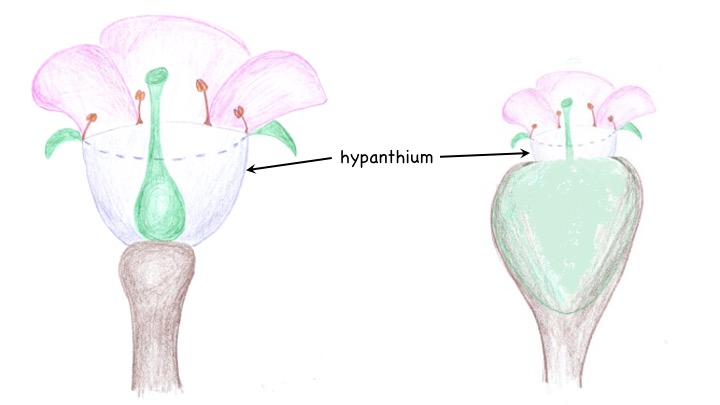
A hypanthium often is formed from the fused bases of the petals, sepals, and stamens. Sometimes, however, it appears to be made from a cup-like expansion of the receptacle.
Regardless of how a hypanthium is formed, we describe the flowers pictured above as having free petals (i.e., petals not fused to any others) attached to a hypanthium. We also consider the sepals free, but attached to a hypanthium. In other words, when determining whether the floral organs are fused or not in a flower with a hypanthium, we ignore the fact that the hypanthium is often the fused bases of these organs. We just call the hypanthium a separate structure.
Some flowers are missing parts.
A complete flower has pistil(s), stamens, petals and sepals. An incomplete flower is missing at least one of these parts.
A perfect flower has both sexes (both stamens and pistils). An imperfect flower is missing either the stamens or the pistils: it is unisexual. Imperfect flowers that are missing pistils are called staminate flowers. (They have stamens.) Imperfect flowers that are missing stamens are called pistillate flowers. (They have pistils.)
In some species individual plants may have only staminate flowers or only pistillate flowers. These species are considered "dioecious", a term meaning "two houses". Species in which individual plants bear both pistils and stamens somewhere on them are termed "monoecious" (one house). Note that monoecious species may have either perfect flowers or imperfect flowers. If they have imperfect flowers, however, both staminate and pistillate flowers have to occur on the same plant for the species to be monoecious.
Comprehension check:
